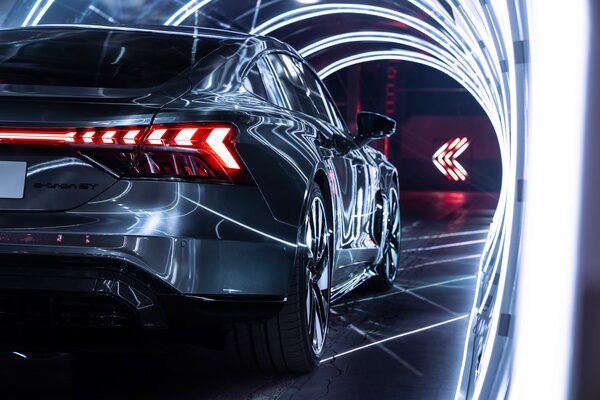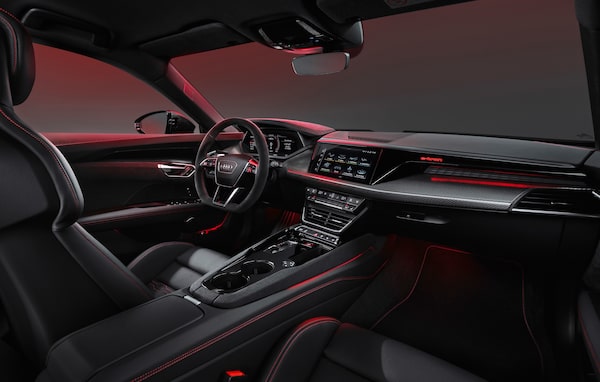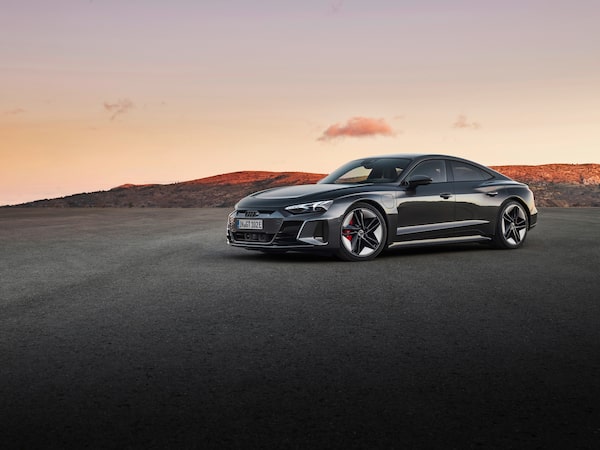
The 2021 Audi e-tron GT electric sedan.Courtesy of manufacturer
After years of waiting, Audi has finally revealed its flagship all-electric e-tron GT sedan, and it looks almost exactly like the concept car shown back in 2018.
That’s both a blessing and a curse, since the production car lives up to expectations set by the stunning concept, but on the other hand, it isn’t all that surprising.
Two versions of the e-tron GT will arrive in Canada this summer, according to a company spokesperson. The e-tron GT quattro will have a driving range of more than 488 kilometres, as rated by the generous WLTP testing standard. The high-performance RS e-tron GT – the first EV from Audi Sport – makes 590 horsepower and can sprint from 0-100 km/h in 3.3 seconds. (For those keeping track, that’s not quite as quick as the refreshed Tesla Model S.) Both versions have dual-motor all-wheel drive and advanced driver-assistance systems. Prices have yet to be announced.
While Audi was building hype around its new flagship electric vehicle (EV), its rivals didn’t stand still. Tesla stole some of Audi’s thunder two weeks ago by launching a refreshed Model S, and Porsche already has three different versions of its electric Taycan – which shares a platform with the new Audi – in showrooms today.
That leaves Audi’s new flagship electric sedan facing some stiff competition and needing to justify its existence.
Audi touted the sustainability of its new EV. “It’s not just the drive concept that’s sustainable; the entire production at our Boellinger Hoefe site now has a carbon-neutral energy balance,” said Markus Duesmann, chairman of the board of Audi AG, in a pre-recorded video presentation. The factory in Germany uses biogas-generated power and carbon credits to achieve carbon neutrality, according to the company. “This sends an important signal for the site, our work force, and certainly for the future of Audi,” he said.

The e-tron GT's design is barely changed from the concept shown in 2018.sagmeister_potography/Courtesy of manufacturer
The e-tron GT joins Audi’s growing EV lineup, which already includes a pair of e-tron SUVs and will later add the smaller Q4 electric SUV as well.
Volkswagen Group, Audi’s parent company, is aiming to surpass Tesla and others to become the world’s leading provider of EVs by 2025. The Group delivered 9.3 million new vehicles last year, despite the pandemic, 231,600 of which were all-electric. The latter figure may not look especially impressive, but it represents a 214-per-cent increase compared to 2019.
Don’t expect Audi’s expensive new flagship electric sedan to significantly boost the Group’s EV sales. In Canada, that task will fall to more affordable mass-market EVs such as Volkswagen’s upcoming ID.4 SUV. No, the e-tron GT is a halo product, meant to burnish Audi’s image and make a splash.
Marc Lichte, head of design at Audi, said this is the most beautiful car he has ever drawn. The concept shown in 2018 was, in fact, a thinly disguised version of the production car. “We changed only two details,” Lichte said in an interview last year. The concept car didn’t have door handles, and it had illuminated badges.
In keeping with the sustainability theme, Audi is giving customers the option to forgo leather in the car. “The term luxury has changed with the age of electric mobility,” said Carla Schink, colour and trim designer at Audi, in another pre-recorded presentation. “For this reason, we have developed two completely leather-free interior packages for the first time,” she said. The cabin combines recycled plastic bottles – 119 of which are used for the seats – with sustainably produced textiles. The wool-like grey fabric and wooden dash give the Audi’s cabin a distinctly modern vibe; it’s a refreshing change from the usually dour German luxury-car cockpits.

The e-tron GT will be available with a sustainability-focused leather-free interior that incorporates recycled plastic bottles.Courtesy of manufacturer
The Audi’s most obvious rival is the Porsche Taycan, a car with which the e-tron GT shares its basic platform and 800-volt electric architecture. In an apparent bid to distinguish its car, Audi touted the grand-touring credentials of its sedan, which explains the “GT” part of the e-tron GT name. Think: comfortable long-distance sports sedan.
Compared to the Taycan, the Audi is slightly longer and taller. The extra height should be a big benefit to rear-seat passengers, who are quite cramped in the Porsche. Still, a Tesla Model S will probably feel even more spacious.
Driving range is a top concern among consumers considering an EV, despite the fact that most people drive much shorter distances per day than modern EVs are capable of, according to a 2019 survey by the consulting firm McKinsey & Company.
The e-tron GT quattro’s 93 kWh battery (with an 85 kWh net capacity) gives a range of 488 kilometres on the European WLTP test cycle. Based on how the similar Porsche Taycan 4S faired in our real-world experience, we’d estimate the Audi will be good for around 400 km or a little more. That would have put the Audi on par with some versions of the Tesla Model S, but Tesla just revamped its old sedan and now claims 663 km of driving range.
Still, the Audi should have a fast-charging advantage. It can recuperate 100 km of range in five minutes, provided you can find a suitable 270 kW public fast-charger.
With the e-tron GT arriving this summer, Audi will have three different EVs in showrooms. Compared to its old nemeses, BMW and Mercedes-Benz, Audi is so far best positioned to rival Tesla’s dominance in the North American luxury EV market.

Courtesy of manufacturer
Shopping for a new car? Check out the Globe Drive Build and Price Tool to see the latest discounts, rebates and rates on new cars, trucks and SUVs. Click here to get your price.
Stay on top of all our Drive stories. We have a Drive newsletter covering car reviews, innovative new cars and the ups and downs of everyday driving. Sign up for the weekly Drive newsletter, delivered to your inbox for free. Follow us on Instagram, @globedrive.